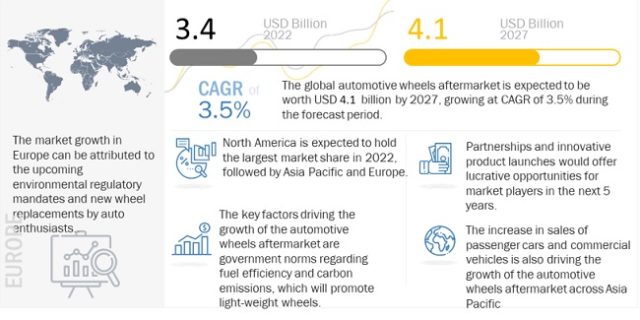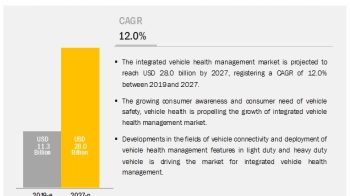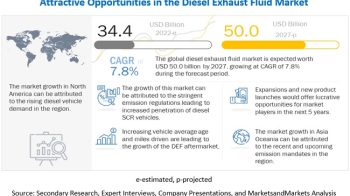
The Automotive Wheels Aftermarket is projected to grow at a CAGR of 3.5% from USD 3.4 billion in 2022 to reach USD 4.1 billion by 2027.
The growth of the automotive wheels aftermarket is influenced by factors such as accident rates, changing consumer preferences for stylish wheels, and the growing number of automobile enthusiasts in Europe and North America. Environmental regulations in Europe mandating a reduction in CO2 is estimated to play a key role in the market over the forecast period as it will put the onus on manufacturers to develop and manufacture wheels made up of alloys and other lightweight materials which Will be one of the key driving factors.
Passenger Cars: Increased passenger car sales and better vehicle handling is expected to drive the automotive wheels aftermarket
The passenger cars segment is the largest of all segments of the automotive wheels aftermarket and is expected to witness significant growth during the forecast period. The growing trend of engine downsizing and vehicle weight reduction without compromising vehicle performance has accentuated the need for wheels made of advanced materials. Passenger cars are now using lightweight alloy wheels that improve the performance of the vehicle. Also, the use of lightweight wheels has resulted in improved vehicle dynamics and performance compared to conventional wheels. Aftermarket wheels for passenger cars come in a vast range of styles to fit the different types of passenger cars. Aftermarket wheels are primarily made of alloys for passenger cars.
Request Sample Report: https://www.marketsandmarkets.com/requestsampleNew.asp?id=179305672
Alloy: Improves the appearance of the wheels
Alloy is expected to be the fastest market for global automotive wheels aftermarket. The growth is due to factors such as corrosion resistance, durability, high tensile strength, density, ductility, and malleability. The two major or commonly used components in the making of alloy wheels are aluminum and magnesium. Aluminum is a lightweight material and is ductile, durable, and corrosion-resistant. Cars manufactured using aluminum are lightweight, fuel-efficient, and emission efficient. Alloy wheels have been increasingly used during the last decade, while the use of regular steel has seen a steady decline in the automotive industry. The use of steel wheels has also declined as aluminum cast wheels have slowly replaced steel wheels, mainly in the passenger vehicle segment.
Asia Pacific: China is expected to lead the Asia Pacific market
The Asia Pacific region is estimated to be the fastest-growing market. The region comprises some of the fastest developing economies of the world such as China and India. The Asia Pacific region is home to key suppliers of automotive wheels such as Enkei (Japan) and Zhejiang Wanfeng Auto Wheel (China). Factors such as the availability of cheap labor and favorable government policies help undertake mass production of automotive components in Asia Pacific, which results in lower prices. In addition, high investments by major OEMs in advanced technologies are providing growth opportunities for the aftermarket wheels manufacturers in this region. China is the largest producer of automobiles in the world. Recent infrastructural developments have boosted the growth of the light-duty vehicle market in the region. Also, nearly all major OEMs have invested in the Chinese market, which is inclined toward small and affordable passenger vehicles. The growing automotive sales levels in China have driven the demand for automotive wheels in the aftermarket.
Inquire Before Buying: https://www.marketsandmarkets.com/Enquiry_Before_BuyingNew.asp?id=179305672
Key Market Players:
The major automotive wheels aftermarket players are RONAL Group (Switzerland), BORBET Gmbh (Germany), Enkei Corporation (Japan), Superior Industries (US), and Maxion Wheels (US).
Related Reports:
Automotive Lightweight Material Market – Global Forecast to 2025
Automotive Specialty Coatings Market – Global Forecast to 2025


